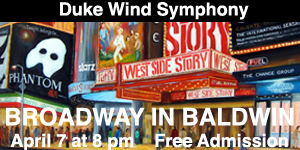During August, the music addict has three choices: go cold turkey, take an expensive trip to the mountains or take in the twice-weekly concerts of the Foothills Chamber Music Festival that are given in the Kuhn Gallery and at Reynolda House in Winston-Salem. Like a speakeasy, the sparkling glass sculptures of the Kuhn Gallery are secreted within an apparently rundown warehouse at the corner of Liberty and Seventh Streets. The great room of Reynolda House is the perfect intimate venue for chamber music, but new fire code regulations have greatly reduced the available seating, so prospective attendees should call in ticket orders early.
The overall theme of this year’s festival is “All Roads Lead to Winston-Salem!” The first Kuhn Gallery concert, on August 4, featured keyboard and art songs of Haydn and Schubert coupled with contemporaneous compositions drawn from the Moravian Archives in Old Salem. Record collectors who have the complete Haydn symphony recordings conducted by Antal Dorati may recall that at least one score came from these archives. While the earliest classical concerts in America were in Charleston and New Orleans, the Moravians certainly played major roles in composing as well as fostering first performances of classical European music here.
The Boston piano in the Kuhn Gallery was played by Byron Schenkman, known internationally for his performances and recordings as both harpsichordist and pianist. Soprano Melissa Fogarty has made a niche for herself in baroque opera and concert without neglecting avant-garde music. Both artists are active in the Seattle area and have recorded for the Centaur label.
Fogarty opened the recital with three songs from the Moravian Archives. The composer of “Ich bin in meinem Geiste” (My Soul Knows Purest Pleasure), David Moritz Michael (1751-1827), conducted the first performance of Haydn’s Creation in America. The text, by Christian Gregor (1719-60), portrays the joys of Christian salvation. While having no really memorable tunes, the music is melodic and well constructed in the early classical style. “Ach Schöpfer nimmt mein Fleisch und Bein” (O Creator, take my flesh and bones), by Johann Daniel Grimm (1719-1760), is a somber setting of a Passion narrative. “Einer ist eurer Meister” (One Alone Is Your Master), by Johannes Herbst (1735-83), is a brief, three-stanza setting. Fogarty’s voice was very even and well supported throughout its range. Her diction was excellent and her intonation, solid. With the piano lid fully up, Schenkman balanced with his soloist well. His articulation of the notes was especially clear, and he made refined and expressive use of dynamics.
Haydn’s cantata Arianna a Naxos ( Ariadne at Naxos ), H.XXVIb:2 proved to be fascinating. This excerpt from the myth dramatizes the rush of emotions Ariadne experiences as she awakens on the island of Naxos and comes to realize that she has been abandoned by Theseus. Haydn’s wide palette and finely-nuanced dynamics were beautifully brought off by Fogarty, who added apt facial expressions and body language. It is too bad that the composer didn’t set the whole myth as an opera. The keyboard accompaniment was equally dramatic.
Two very dissimilar, freely-constructed pieces by Haydn gave Schenkman ample opportunity to display a wide range of expression. The composer uses a whole bag of tricks in his Fantasia in C, H.XXVIb:2. A single fortissimo chord is used in the “Surprise” Symphony, multiple false cadences occur in the finale of the Quartet in D, Op. 76/5, and a very long-held pause is in the finale of Quartet in E-flat, Op. 33/2, but all these and more pepper the Fantasia, which gives it a funhouse atmosphere. Haydn anticipated Johnny Carson’s comic “Rule of Three” (never use the same premise three times in a row), juxtaposing effects in a jumble impossible to anticipate. One can only imagine what an 18th-century listener would have made of this! Every note was crystal clear no matter the tempo or abrupt changes of dynamics. The mood and timbre of the more staid Adagio in G, H.XV:22(II), was perfectly captured.
The rippling waves of water evoked in the piano part of the song “Auf Blauen Wassern” (On Waters Blue), by Moravian composer Ernst Immanuel Erbe (1854-1927), made me think of Schubert more than once. Fogarty captured the blissful mood of two lovers in a boat perfectly. Her increasing inebriation as the toasting minstrel in “Ein Kehr” was comic and almost too real.
Three songs by Schubert ended the concert. From my years of reading Lieder scholars grumbling about too much nuance being given to the words by Fischer-Dieskau or Schwarzkopf, I suspect traditional critics would have paled or swooned at Fogarty’s dramatic interpretations. She prefaced her performance by saying that the songs were chosen to parallel the first half of the recital. The seldom sung “Amalia,” a setting of the heroine’s song in Schiller’s Die Räuber , recalls the fiery kisses and caresses of a lost love. Schenkman’s steady rhythm suggested the spinning wheel at which the young girl in “Gretchen am Spinnrade” is bewildered by the throes of first love. In Schubert’s Songs, Richard Capell writes of “Litanei” (a setting in memory of its poet Johann Georg Jacobi) “there was never a truer or more touching expression of simple devotion and of grief consoled and yet still near to weeping.” This last song matched the resigned religious mood of the opening Moravian works.











